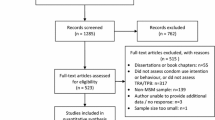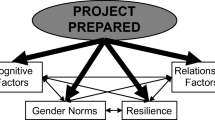Abstract
The current study compares the effectiveness of interventions that attempted to uniquely influence hypothesized determinants of behavior in the Theory of Planned Behavior versus some optimal combination of constructs (three constructs vs. four) to increase condom use among intentions and behavior college students. 317 participants (Mage = 19.31; SDage = 1.31; 53.3% female; 74.1% Caucasian) were randomly assigned to one of seven computer-based interventions. Interventions were designed using the Theory of Planned Behavior as the guiding theoretical framework. 196 (61.8%) completed behavioral follow-up assessments 3-month later. We found that the four construct intervention was marginally better at changing intentions (estimate = − .06, SE = .03, p = .06), but the single construct interventions were more strongly related to risky sexual behavior at follow-up (estimate = .04, SE = .02, p = .05). This study suggests that these constructs may work together synergistically to produce change (ClinicalTrials.gov Number NCT# 02855489).


Similar content being viewed by others
References
Aiken, L. S. (2010). Advancing health behavior theory: The interplay among theories of health behavior, empirical modeling of health behavior, and behavioral interventions. In H. Friedman (Ed.), Oxford handbook of health psychology (pp. 1–39). New York City: Oxford University Press.
Ajzen, I. (1991). The theory of planned behavior. Organizational Behavior and Human Decision Processes, 50, 179–211.
Ajzen, I., & Fishbein, M. (1980). Understanding attitudes and predicting social behavior. Englewood Cliffs, NJ: Prentice-Hall.
Ajzen, I., & Madden, T. J. (1986). Prediction of goal-directed behavior: Attitudes, intentions, and perceived behavioral control. Journal of Experimental Social Psychology, 22, 453–474.
Albarracín, D., Johnson, B. T., Fishbein, M., & Muellerleile, P. A. (2001). Theories of reasoned action and planned behavior as models of condom use: A meta-analysis. Psychological Bulletin, 127, 142–161.
American College Health Association (ACHA). (2014). American college health association-national college health assessment II: Undergraduate students reference group data report spring 2014. Hanover, MD: American College Health Association.
Armitage, C. J., & Conner, M. (2001). Efficacy of the theory of planned behaviour: A meta-analytic review. The British Journal of Social Psychology, 40, 471–499.
Asch, S. E. (1956). Studies of independence and conformity: I. A minority of one against a unanimous majority. Psychological Monographs: General and Applied, 70, 1–70.
Bandura, A. (1977). Self-efficacy: Toward a unifying theory of behavioral change. Psychological Review, 84(2), 191–215.
Bandura, A. (1982). Self-efficacy mechanism in human agency. American Psychologist, 37(2), 122–147.
Bandura, A. (1985). Social foundations of thought and action: A social cognitive theory. Englewood Cliffs, NJ: Prentice-Hall Inc.
Bandura, A. (1986). The explanatory and predictive scope of self-efficacy theory. Journal of Social and Clinical Psychology, 4(3), 359–373.
Bandura, A. (1989). Human agency in social cognitive theory. The American Psychologist, 44, 1175–1184.
Bauman, L. J., Karasz, A., & Hamilton, A. (2007). Understanding failure of condom use intention among adolescents completing an intensive preventive intervention. Journal of Adolescent Research, 22, 248–274.
Brien, T. M., Thombs, D. L., Mahoney, C. A., & Wallanu, L. (1994). Dimensions of self-efficacy among three distinct groups of condom users. Journal of American College Health, 42, 167–174.
Bryan, A. D., Aiken, L. S., & West, S. G. (1996). Increasing condom use: Evaluations of a theory-based intervention to prevent sexually transmitted diseases in young women. Health Psychology, 15, 371–382.
Bryan, A., Schmiege, S. J., & Broaddus, M. R. (2007). Mediational analysis in HIV/AIDS research: Estimating multivariate path analytic models in a structural equation modeling framework. AIDS and Behavior, 11, 365–383.
Centers for Disease Control and Prevention (CDC). (2012). STDs in adolescents and young adults. Retrieved March 23, 2014, from http://www.cdc.gov/std/stats11/adol.htm
Conner, M. (2014). Extending not retiring the theory of planned behaviour: A commentary on Sniehotta, Presseau and Araújo-Soares. Health Psychology Review, 9, 141–145.
Conner, M., Rhodes, R. E., Morris, B., McEachan, R., & Lawton, R. (2011). Changing exercise through targeting affective or cognitive attitudes. Psychology and Health, 26(2), 133–149.
Desmond, D. P., Maddux, J. F., Johnson, T. H., & Confer, B. A. (1995). Obtaining follow-up interviews for treatment evaluation. Journal of Substance Abuse Treatment, 12, 95–102.
Gollwitzer, P. M. (1993). Goal achievement: The role of intentions. In W. Stroebe & M. Hewstone (Eds.), European review of social psychology (Vol. 4, pp. 141–185). London: Wiley.
Gollwitzer, P. M. (1999). Implementation intentions: Strong effects of simple plans. American Psychologist, 54, 493–503.
Hagger, M. S., Chan, D. K., Protogerou, C., & Chatzisarantis, N. L. (2016). Using meta-analytic path analysis to test theoretical predictions in health behavior: An illustration based on meta-analyses of the theory of planned behavior. Preventive Medicine, 89, 154–161.
Hagger, M. S., Gucciardi, D. F., & Chatzisarantis, N. L. (2017). On nomological validity and auxiliary assumptions: The importance of simultaneously testing effects in social cognitive theories applied to health behavior and some guidelines. Frontiers in Psychology, 8, 1–14.
Hofmann, W., De Houwer, J., Perugini, M., Baeyens, F., & Crombez, G. (2010). Evaluative conditioning in humans: A meta-analysis. Psychological Bulletin, 136, 390–421.
Holtforth, M. G., Castonguay, L. G., Borkovec, T. D., & Building, M. (2004). Expanding our strategies to study the process of change. Clinical Psychology: Science and Practice, 11, 396–404.
Janz, N. K., & Becker, M. H. (1984). The health belief model: A decade later. Health Education Quarterly, 11, 1–47.
Jemmott, J. B., III, Jemmott, L. S., & Fong, G. T. (1998). Abstinence and safer sex HIV risk-reduction interventions for African American adolescents: A randomized controlled trial. JAMA, 279, 1529–1536.
Lo, S. H., Good, A., Sheeran, P., Baio, G., Rainbow, S., Vart, G., et al. (2014). Preformulated implementation intentions to promote colorectal cancer screening: A cluster-randomized trial. Health Psychology, 33, 998–1002.
Magnan, R. E., Callahan, T. J., Ladd, B. O., Claus, E. D., Hutchison, K. E., & Bryan, A. D. (2013). Evaluating an integrative theoretical framework for HIV sexual risk among juvenile justice involved adolescents. Journal of AIDS & Clinical Research, 4, 217.
McEachan, R. R. C., Conner, M., Taylor, N. J., & Lawton, R. J. (2011). Prospective prediction of health-related behaviours with the theory of planned behaviour: A meta-analysis. Health Psychology Review, 5, 97–144.
Michie, S., Richardson, M., Johnston, M., Abraham, C., Francis, J., Hardeman, W., et al. (2013). The behavior change technique taxonomy (v1) of 93 hierarchically clustered techniques: Building an international consensus for the reporting of behavior change interventions. Annals of Behavioral Medicine, 46, 81–95.
Milgram, S. (1964). Group pressure and action against a person. The Journal of Abnormal and Social Psychology, 69, 137–143.
Montanaro, E. A., & Bryan, A. D. (2014). Comparing theory-based condom interventions: Health belief model versus theory of planned behavior. Health Psychology, 33, 1251–1260.
Montanaro, E., Fiellin, L. E., Fakhouri, T., Kyriakides, T., & Duncan, L. R. (2015). Using videogame applications to assess gains in substance use knowledge in adolescents: New opportunities for evaluating intervention exposure and content mastery. Journal of Medical Internet Research, 17, e245.
Noar, S. M., & Zimmerman, R. S. (2005). Health behavior theory and cumulative knowledge regarding health behaviors: Are we moving in the right direction? Health Education Research, 20, 275–290.
Peters, E., Klein, W., Kaufman, A., Meilleur, L., & Dixon, A. (2013). More is not always better: Intuitions about effective public policy can lead to unintended consequences. Social Issues and Policy Review, 7, 114–148.
Reid, A. E., & Aiken, L. S. (2011). Integration of five health behavior models: Common strengths and unique contributions to understanding condom use. Psychology & Health, 26, 1499–1520.
Rivis, A., & Sheeran, P. (2003). Descriptive norms as an additional predictor in the theory of planned. Current Psychology: Developmental, Learning, Personality, Social, 22, 218–233.
Schafer, J. L., & Graham, J. W. (2002). Missing data: Our view of the state of the art. Psychological Methods, 7, 147–177.
Schmiege, S. J., Broaddus, M. R., Levin, M., & Bryan, A. D. (2009). Randomized trial of group interventions to reduce HIV/STD risk and change theoretical mediators among detained adolescents. Journal of Consulting and Clinical Psychology, 77, 38–50.
Shadish, W. R., Cook, T. D., & Campbell, D. T. (2002). Experimental and quasi-experimental designs for generalized causal inference. Boston: Wadsworth Cengage Leaning.
Sheeran, P., Klein, W. M., & Rothman, A. J. (2017). Health behavior change: Moving from observation to intervention. Annual Review of Psychology, 68, 573–600.
Sheeran, P., Maki, A., Montanaro, E., Avishai-Yitshak, A., Bryan, A. D., Klein, W. M. P., et al. (2016). The impact of changing attitudes, norms, and self-efficacy on health-related intentions and behavior: A meta-analysis. Health Psychology, 35, 1178–1188.
Sherman, D. K., Kinias, Z., Major, B., Kim, H. S., & Prenovost, M. (2007). The group as a resource: Reducing biased attributions for group success and failure via group affirmation. Personality and Social Psychology Bulletin, 33, 1100–1112.
Sniehotta, F. F., Presseau, J., & Araújo-Soares, V. (2014). Time to retire the theory of planned behaviour. Health Psychology Review, 8, 1–7.
Spencer, S. J., Zanna, M. P., & Fong, G. T. (2005). Establishing a causal chain: Why experiments are often more effective in examining psychological process than mediational analyses. Journal of Personality and Social Psychology, 89, 845–851.
Stangor, C., Sechrist, G. B., & Jost, J. T. (2001). Changing racial beliefs by providing consensus information. Personality and Social Psychology Bulletin, 27, 486–496.
Trafimow, D., & Finlay, K. A. (1996). The importance of subjective norms for a minority of people: Between subjects and within-subjects analyses. Personality and Social Psychology Bulletin, 22, 820–828.
Webb, T. L., & Sheeran, P. (2008). Mechanisms of implementation intention effects: The role of goal intentions, self-efficacy, and accessibility of plan components. British Journal of Social Psychology, 47, 373–395.
Williams, G. C., Freedman, Z. R., & Deci, E. L. (1998). Supporting autonomy to motivate patients with diabetes for glucose control. Diabetes Care, 21, 1644–1651.
Acknowledgements
Dr. Erika Montanaro was supported by T32MH020031 from the National Institute of Mental Health. The content is solely the responsibility of the authors and does not necessarily represent the official views of the National Institute of Mental Health or the National Institutes of Health.
Author information
Authors and Affiliations
Corresponding author
Ethics declarations
Conflict of interest
Erika A. Montanaro, Trace S. Kershaw, Angela D. Bryan declares that they have no conflict of interest.
Human and animal rights and Informed consent
All procedures performed in studies involving human participants were in accordance with the ethical standards of the institutional and/or national research committee and with the 1964 Helsinki declaration and its later amendments or comparable ethical standards. Informed consent was obtained from all individual participants included in the study.
Appendix
Rights and permissions
About this article
Cite this article
Montanaro, E.A., Kershaw, T.S. & Bryan, A.D. Dismantling the theory of planned behavior: evaluating the relative effectiveness of attempts to uniquely change attitudes, norms, and perceived behavioral control. J Behav Med 41, 757–770 (2018). https://doi.org/10.1007/s10865-018-9923-x
Received:
Accepted:
Published:
Issue Date:
DOI: https://doi.org/10.1007/s10865-018-9923-x




